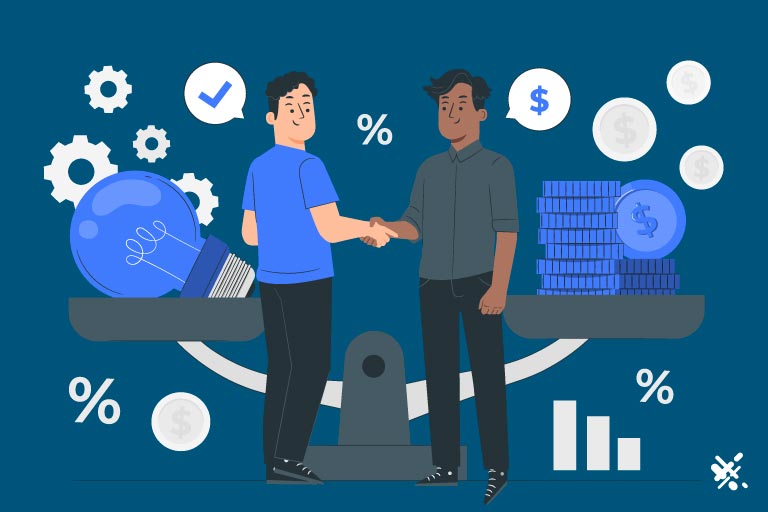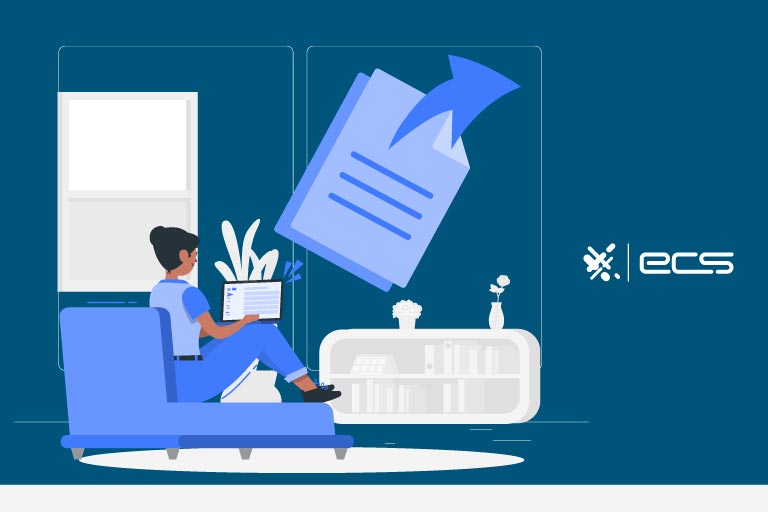The difference between push and pull is like opposite sides of the coin, you might say. You might be asking yourself. What does pushing pay mean? Well, to push money means to give it or send it. Conversely, to pull money means to take it—as you might guess.
So in that sense, pushing and pulling happen at the same time. However, when it comes to debit, credit, and ACH transactions, push and pull mean something more specific.
A Brief History of Push Pay and Pull Pay
For thousands of years, consumers, merchants, and even kings paid for goods and services in metal coinage, such as gold and silver. The applicability of “push payment” came from the fact that the payor offered coinage to the payee. In this sense, the payor was in full control of the payment. When it was made and how much it would be.
The opposite of this paradigm would be the payee (or end recipient) taking or pulling a payment from the domain of the payor. This would be a far less likely form of transaction. Especially because most people didn’t keep their money in a bank. Although it’s somewhat of a gross oversimplification, everyone had their own little sacks of coins. It would certainly be a faux pas for someone else to reach their hand in there and take even a pre-agreed amount.
Of course, in a purview of history, one can imagine such a payment scenario occurring during a Viking raid: for the pleasure of not seeing our longships again this year, we’ll be pulling one chalice, two candlesticks, and this richly decorated coloring book from your monastery. And as this is a subscription service, expect to see us again next year.
Were Pull Payments Used by Merchants Before Cards?
But a more serious potential scenario where pull payments might occur was when a customer left a deposit with a merchant. The customer-payor would run up a tab with the merchant-payee, who would then deduct the tab from the deposit. Think of a bar tab, or a grocery tab, without having to hand over your card every time.
Although it seems strange in our world of plastic payments, the deposit and tab system was a core part of grocery shopping for centuries. So was having a grocer behind the counter assemble your order from a limited selection of brands before Piggly Wiggly invented the shop-for-yourself grocery store experience. But that’s a wiggle for another piggle.
In any case, remember the deposit-tab paradigm for later. For, in our discussion of pull payments, we will circle back to it. Interestingly, companies like Amazon have once again begun to leverage this model in their chain of automated stores. Where you can have whatever you like, but you’ll have to pay for it later. Amazon sees and hears everything, after all—especially if you have an Alexa in your home.
Are Checks Pull Payments or Push Payments?
Eventually, consumers and merchants began to store their excess money in banks. Since nobody was really asking for this money on a regular basis, the banks realized they could loan it out and collect more money in the form of interest. If one party needed to pay another, they would write a check for the specific amount of payment in question.
The payee would then take the check to their bank and cash it or deposit it. Receiving an equivalent sum of money commensurate with the amount written on the check. The bank would then take the money out of the payor’s account. Or arrange with the payor’s bank to make that happen.
The settling of these funds resulted in what can perhaps be seen as a pull payment since funds would be taken out of the payor’s account. But remember that they initiated the transfer by handing over a check, essentially making it a push transaction.
Debit, Credit, and ACH Payments to Push Payment
It was not until the advent of credit, debit, and ACH payments that true pull transactions came into existence. That’s because a pull payment is initiated by the one getting paid. It’s an automated, back-end process. The details of which they are in control (although both parties must obviously agree to this arrangement beforehand).
Debit cards are directly linked to a bank account. And a payment made with a debit card will debit money out of that account. So, eventually, it can be credited to the merchant’s account. First, it will have to pass through the payment landscape of being transferred from financial institution to institution. But in summary, that’s a basic overview.
A credit card is a little different. The cardholder has a credit line with the card issuer. As they make a purchase, it becomes part of an outstanding balance that must be paid. Which also reduces the amount of available credit.
Card networks like Visa, Mastercard, Discover, and American Express facilitate a transfer of funds to the merchant. These funds were fronted by the credit card company on behalf of the cardholder, who now owes the card issuer that money, plus interest.
What About Recurring Payments?
Either way—whether a customer is paying for something with a credit card or debit card—these are examples of push payments. The card information is in the hands of the payer or in their mobile wallet. When the time comes to make a purchase or pay for services rendered, they take out the card and present it to the merchant, or enter its details into an online payment gateway.
But what if there is going to be an ongoing arrangement between the customer and the merchant? What if they are signing up for a subscription service? Or what if they’re getting a monthly bill—which although it may vary in amount—they would like to set on autopilot, without having to initiate the payment? That’s where pull payment comes into play.
What is a Pull Payment?
A pull payment is initiated by the payee. This is facilitated by collecting payment information from the payor and entering into an ongoing payment agreement. This agreement may be ad infinitum (forever) or for a set number of installments.
Either way, the payee will need to collect details from the payor like card number, name on the card, card expiration date, and (depending on the payment processor) expiration date and security code.
Once this information is collected, the payor can pull a payment from the customer on an ongoing basis. If it’s done from a debit card, the money will come right from the customer’s checking account. If it’s done from a credit card, it will come off their credit line, and the customer will have to eventually settle the outstanding balance with their financial institution.
What Businesses Should Use Pull Payments?
Either way, it’s an excellent way for businesses to make sure they get paid on time. Common examples of business models that can use pull payments to their advantage are those businesses sending customers a periodic (but varying) bill and subscription services.
Billed services might include things like utilities, insurance, rent, or ongoing services rendered—for example, a lawyer or accountant who is retained by a client but requires payment for some additional services rendered in the past payment period.
Pull payments are also a must-have for subscription services. The subscription service model involves charging customers for access to what is usually a cloud-based service. Entertainment platforms like Netflix, DisneyPlus, and Amazon Prime are all subscription services.
B2B software like Salesforce, Monday, and Workiva are solutions that help with productivity, teamwork, and customer relationship management. All these business models are built on a cash flow of subscribers who have previously agreed to periodic payments.
Is Payroll a Pull Payment?
Although payroll is automated, it is not a pull payment. Rather, it is an automated push payment, specifically a direct debit ACH credit (more on that later). Remember that pull payments are initiated by the payee, who is in control of details like the amount and the date. Although most employees would love to set their own wages, this is obviously not a functional economic model…although some lawmakers seem to think it is. Good luck to them, we say!
What are Push to Card Payments?
Push-to-card payments is a relatively new technology. Practically speaking, it’s similar to some of the P2P money transferring fintech that has already existed for some time, such as PayPal or CashApp. The difference is that push-to-card payments go right to the payee’s debit card. Not onto the actual card, of course, but into the checking account associated with that card.
Not all banks and financial institutions are equipped to accept push-to-card payments. But for those that are, this can be a very convenient way for someone to get their money…quickly. While bank transfers can take 24-48 hours, and apps like PayPal and CashApp may present limitations on depositing balances into a checking account (such as time or additional fees), push-to-card payments are instantaneous.

People Love Getting Paid NOW
That’s why some gig work platforms are offering push-to-card payments for platform users. For instance, Visa has partnered with software giant Oracle to create the Visa Direct application. This app will allow gig workers to circumnavigate the ACH network and get payments sent right to their debit cards.
Gig work platforms like Postmates and Upwork are already using the Visa solution or others to allow workers to “get paid instantly” in exchange for a small fee that is far below the percentage rake collected by the likes of PayPal for the same speed.
Payroll platforms like PayActiv, which is not for gig workers but for employers (and employees) are also integrating push payments so that workers can get paid faster. Some of these solutions may integrate with cash advance apps like Chime.
In the ever-evolving landscape of gig work and even employed W2 work, the rapidity of payment may become as much a selling point as health insurance. This may be especially true in the service sector. Wherein a vast majority of the workforce is already living paycheck to paycheck.
Do Card Networks like Pay Push Paradigms?
At this time, push-to-pay options are mostly for debit cards linked to checking accounts of financial institutions that can integrate with the technology. But card networks like Mastercard have seen the value of push payments.
In a study of their Mastercard Send solution, Mastercard found that Uber drivers who received push payments used their plastic 20% more. Google Pay customers spent 13% more. Small business owners receiving push payments spent 46% more on those same cards.
In general, Mastercard concluded that push to debit payments resulted in increasing card usage. Money can burn a hole in your pocket, they say. And that adage seems to have some psychological import, as both in consumer and business contexts, push payments resulted in more spending. Which of course means more fees for card networks. Since money talks, it’s likely that card networks will continue to develop push-to-card solutions as a win-win scenario for cardholders and card issuers.
What is Authorized Push Payment Fraud?
Where there’s a will, there’s a way…and where there’s a way, wills can go to work. Remember that push payments are initiated by the payor, to the payee. This means that nobody can forcibly come into your bank account and pull payment out of it. But what if they can trick you into initiating a push payment yourself?
That’s where push payment fraud comes into play. Push payment fraud is all about getting the victim to send money through some social engineering. Posing as someone or something (a business, that is) who already has a relationship with the victim. The criminal will ask for money.
This information can be obtained by hacking into the victim’s personal information, or even by stalking their social media profiles. With the advent of machine learning, criminals can use the tip of the iceberg to get all the information they need in order to pose as a company or person the victim supposedly knows.
Push Pay Romance Scams
Sometimes the scams rely more on emotion than elaborate setups. In romance scams, a man or woman might befriend someone on social media. They will build up a long and elaborate relationship before asking for money. Often this money “is needed” to help the lover get into the arms of their beloved (first class please) or some other heartstring-pulling story. Once the victim sends their funds, the criminal disappears.
You may be wondering why the police can’t just partner with financial institutions to locate these criminals. Many times the criminals themselves don’t leave enough clues in place for the authorities to track. And as real-time payments are often irreversible, once the damage is done, it’s done. Hearts may be broken along the way, but hopefully, the victim learns their lesson.
As such, push payment fraud does not necessarily refer to push to card payments. It really can just be used as a catchall term for scams where the criminal tricks the victim into willingly pushing money in their direction. A sort of spin on the classic take-your-money motif. Perhaps with little more elaborate storylines, costumery, and at the very least, a good story to laugh…or cry about.
What About Pull Payment Fraud?
Tangentially, there’s not really such a thing as pull payment fraud. That would just be called stealing. When a customer hands over payment details for recurring billing, they do so with the understanding that they will receive some ongoing goods or services in return. If that doesn’t happen, it’s just plain old misrepresentation, or someone stealing their card details.
This, of course, is a separate problem that is also very serious. And driving an entire security aspect of the payment landscape vis-a-vis tokenization and blockchain. But that’s an email from your long-lost African uncle for another day.
Push and Pull in the ACH
Push and pull payments also occur in the ACH network, in addition to card networks. The Automated Clearing House Network facilitates bank-to-bank transfers using checking account numbers and routing numbers. There are no checks, no cards, and no cash involved. Just a network of operators sending money from one bank to another.
In the case of push payments, the ACH network may be a less likely candidate than cards, cash, or even check. Remember that push payments are initiated by the payer. They are often a one-time affair, such as payment for a good or service, Instead of a recurring bill or subscription membership.
Pull payments in the ACH network are really where the excitement is at. Woo-hoo! That’s because pull payments are actually perfect for ACH transactions, for a few reasons. One is the avoidance of interchange fees.
While the price of accepting Visa, Mastercard, Discover, and Amex can range from 2% to 4%, the average ACH payment costs less than three dimes.
Another reason that pull payments via ACH are beneficial is that the ACH network uses banking information that doesn’t change: checking account numbers and routing numbers. By contrast, debit and credit card numbers do change.
The cards can get lost or stolen. And even if they don’t, they still expire after a few years. These changes can result in disrupted cash flow. Because the card number a merchant has on file is no longer relevant. Something that doesn’t occur with ACH payments.

Push and Pull versus Credit and Debit
But it’s actually more common to hear the terms credit and debit used in the context of ACH, rather than push and pull. The concepts are somewhat similar, in that these terms relate to who is sending the money.
A debit involves pulling money out of an account, and a credit involves putting money into it. A common example of a debit ACH payment includes monthly subscription fees. And a common example of an ACH credit includes payroll direct deposit.
That said, you might describe ACH credits as a push payment, and ACH debits as a pull payment. But again, credit and debit are more common terms in the parlance of the Automated Clearing House Network.
Will Pull Payments Replace Push Payments?
Pull payments may indeed replace push payments in certain consumer-facing market sectors because of automated store models. Amazon, the internet commerce behemoth, has been experimenting with this model since 2018.
Amazon Go Stores allow customers to shop and exit the store with whatever they’d like. Sensors pick up on the items they are removing and charge their account accordingly. Unlike the traditional model of buying stuff for centuries, there is no transaction to end the shopping experience. And no small talk either.
Amazon charges customers for the item with a card they have on file, in what is essentially a pull payment. There is no traditional push of funds from the customer to the merchant. Just the lonely sound of silence in a cashier-less world. Amazon has rolled out 15 such stores in London and about three dozen others across Seattle, Chicago, San Francisco, and New York.
It will be interesting to see how cashier-less stores jive with districts that have cashless bail and that have decriminalized shoplifting under $950. Perhaps this is where drones and robot dogs come into the picture.
In any case, pull payments may have the potential to disrupt a face-to-face consumer payment landscape that is entirely made up of push payments—that is, customer-initiated. Ironically, these advances in technology may bring the retail landscape back to those original days of shopping with a tab.

Push Us an Email, Chat, or Phone Call
Both types of payments can bring significant benefits to your business, particularly if you recurringly charge your customers.
To contact sales, click HERE. And to learn more about ECS Payment Processing visit Credit & Debit.
